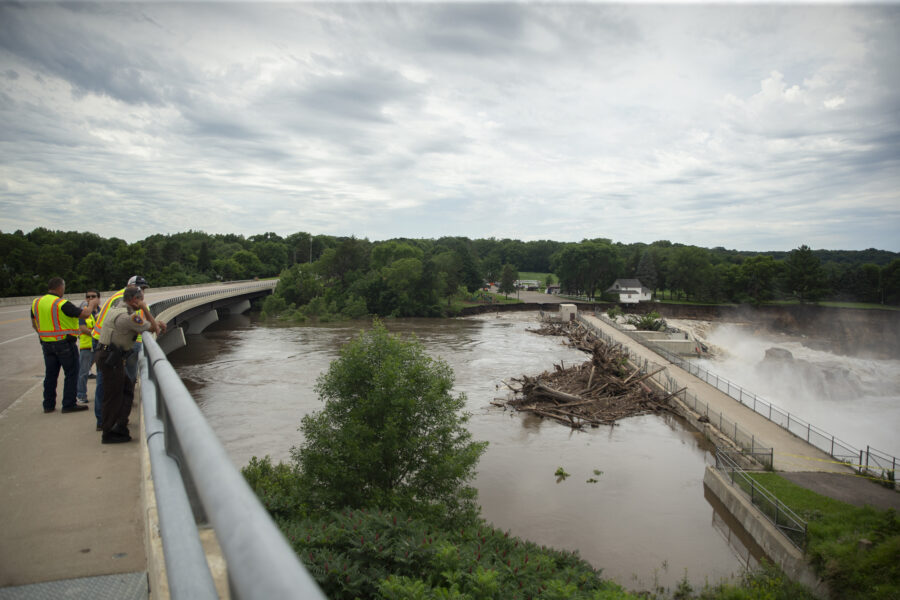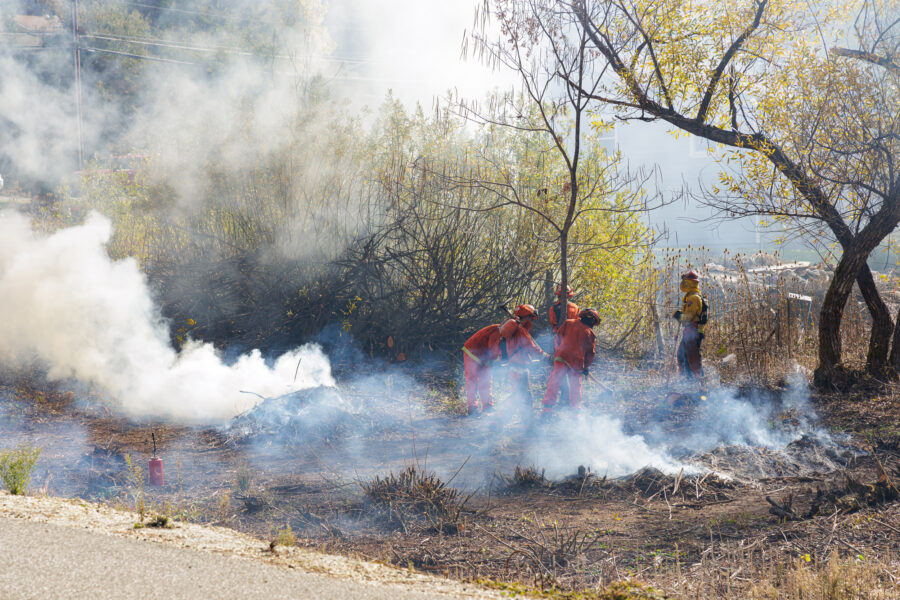California Ballot Asks Voters to Invest in Climate Solutions
Following yet another year of brutal heatwaves and devastating wildfires, Californians have the chance to tell elected officials they support urgent climate action by voting for a $10 billion climate resilience bond on the November ballot.
During an unprecedented budget surplus two years ago, California earmarked $54 billion to forge “an oil-free future” and protect residents from the extreme effects of climate change. That surplus morphed into a multibillion-dollar deficit within a year, after rosy projections of rising revenues from income taxes failed to materialize, forcing Gov. Gavin Newsom and state lawmakers to cut and defer billions from their ambitious climate spending plans.
California’s budget problems will likely continue, analysts say, as will the climate change-fueled disasters that have battered the state. To provide a stable source of funding for urgently needed climate action, legislators passed a bill in July that seeks voters’ approval to authorize the state to borrow $10 billion to underwrite climate resiliency projects. Newsom signed it the same day.
Explore the latest news about what’s at stake for the climate during this election season.
Now scientists, policymakers, climate experts and environmental justice advocates are among those urging voters to support the Safe Drinking Water, Wildfire Prevention, Drought Preparedness and Clean Air Bond Act of 2024, on the ballot as Proposition 4.
“Multiple excellent studies show that paying now will save lives and save dollars,” said Ellie Cohen, CEO of The Climate Center, a nonprofit dedicated to reducing climate pollution, and a member of the Yes on 4 campaign. “Even a short-term delay in adopting strong climate policies dramatically increases the cost of decarbonization and risks irreversible ecological impacts,” she said.
A warmer climate is likely to permanently alter ecosystems, trigger a wave of species extinctions and reduce crop yields through more frequent heat waves and drier soil, a 2021 report by the nonpartisan think tank Energy Innovation Policy & Technology warned.
Failing to prepare for catastrophic wildfires, drought, extreme heat and other extreme events could cost the state an estimated $113 billion in damages a year by 2050, according to California’s Fourth Climate Change Assessment. Most of the costs come from lives lost, impacts from drought and damage to coastal properties and inland regions hit by the type of weeks-long flooding that killed thousands and bankrupted the state during the 1861-1862 megaflood.
“Even a short-term delay in adopting strong climate policies dramatically increases the cost of decarbonization and risks irreversible ecological impacts.”
— Ellie Cohen, CEO of The Climate Center
Yet $113 billion a year is likely an underestimate. The assessment did not account for the costs of several other climate-related disasters, including health harms and property damage from wildfires, illness and death from extreme heat and impacts of drought on water quality, wildlife and ecosystems. Damages from the calamitous 2018 wildfires cost nearly $150 billion, a peer-reviewed study found.
Investing in Resilience Pays
Responding to climate disasters costs exponentially more than investing in resilience, experts say. Every dollar spent on climate preparedness saves $6 on disaster relief, according to Federal Emergency Management Agency estimates. That means investing $10 billion in climate resiliency now could avoid a $60 billion cleanup and recovery bill down the road.
If voters approve Prop. 4, state officials will immediately start funding projects to improve access to safe drinking water, reduce risks from wildfire and drought, make food systems more resilient, restore habitats and protect communities, farmland and ecosystems from climate risks.
“Bond funds are an appropriate and very effective way to fund many of the climate change-adaptation actions that many cities and counties are planning right now but don’t have local revenue sources to support,” said Laura Engeman, an environmental scientist at the University of California, San Diego. “A lot needs to be done around coastal resilience, in terms of environmental restoration as well as the connection between restoration and public infrastructure. These bonds provide a way to plan a lot of that.”
For example, many jurisdictions are looking at restoring sand dunes, wetlands and other ecosystems to protect infrastructure like roads and water systems, Engeman said.
“We saw a lot of degradation and erosion at our beaches over these last two years, which were big storm years,” she said. “You’re seeing a number of different cities right now that are looking at immediate needs for repair, recovery and building what we call ‘a coastal resilience buffer’ into the beach and shoreline landscape to buy a little bit of time to figure out how to actually adapt.”
Other projects include wetlands restoration, which involves upgrading bridges to expand the space for water to move and drain during floods, and retooling watersheds that channel polluted floodwaters into public spaces. “The bond is a good use of public dollars because there are a lot of benefits to the broader community,” Engeman said. “We’re saving money on the back end by spending money up front.”
Prop. 4 would support loans and grants to local governments, Native American tribes, nonprofit organizations and businesses to reduce the risks and impacts of a warming world.
The largest share would go to safeguarding drinking water and dwindling groundwater supplies, and protecting rivers and streams from toxic pollution ($3.8 billion), followed by investments in wildfire prevention and extreme heat mitigation ($1.95 billion), protection of natural lands, parks and wildlife ($1.9 billion), protection of coastal lands, bays and oceans ($1.2 billion), transitioning to clean energy ($850 million) and supporting climate-smart agriculture ($300 million).
Advancing Climate Justice
Prop. 4 ensures that at least 40 percent of funds go to projects that benefit vulnerable and disadvantaged communities, in keeping with the Biden administration’s Justice40 Initiative.
“A significant part of this bond prioritizes the frontline communities that bear the brunt of climate change impacts and impacts from the fossil fuel industry,” said The Climate Center’s Cohen.
California officials released an updated plan to protect communities from extreme heat in 2022, noting that “every corner” of the state will be affected by higher average temperatures and more frequent and severe heat waves. Farmworkers are increasingly vulnerable to heat-related illness and death, particularly in regions with chronically bad air, as Inside Climate News reported last year. Prop. 4 would allocate $450 million to help primarily disadvantaged communities and vulnerable populations adapt to extreme heat.
Access to safe drinking water has been a human right in the Golden State since 2012, yet close to 400 public water systems fail to meet drinking water standards. Nearly a million residents, primarily in low-income communities and communities of color, lack clean water in their homes, according to the state water board. Another 1.5 million people rely on water systems at risk of failing.
The bond earmarks $610 million to provide safe, affordable, reliable sources of drinking water, including to tribal communities, and to develop drought-contingency plans and monitor for contaminants like PFAS “forever chemicals,” which have been detected in supplies serving more than 25 million people, the nonprofit Natural Resources Defense Council recently reported.
Some of California’s most endangered resources would also benefit. The bond allocates $170 million to improving air quality, public health and habitat around the beleaguered Salton Sea, which supports more than 120,000 migrating shorebirds, several species of concern and hundreds of other bird species southeast of Palm Springs. Another $50 million would go to restoring the state’s critically endangered salmon populations.
The proposition has broad support from environmental groups, environmental justice advocates, labor unions, water agencies and renewable energy companies. Opposition includes the Howard Jarvis Taxpayers Association, which called it “reckless to use borrowed money” and Republican legislators led by the minority leader of the state Senate, Brian Jones (R-San Diego), who believes bond debt will only worsen California’s budget crisis.
Repaying the amount borrowed with interest is likely to cost taxpayers $400 million a year over 40 years, a state legislative analyst said, ultimately costing $16 billion.
It’s not certain voters will accept more debt. Despite California’s liberal reputation, voters tend to be conservative when it comes to bond measures, survey expert Mark Baldassare of the nonpartisan Public Policy Institute of California recently reported. Even so, 65 percent of likely voters said they would vote yes on Prop. 4 in a survey PPIC released this week.
The Climate Center’s Cohen acknowledged that many don’t like paying more to support government action. “But the bottom line is, our fossil fuel economy has resulted in a climate crisis that I liken to a runaway train,” she said. “We’re all standing on the track, it’s accelerating towards us and we are not doing enough to slow it down.”
She sees Prop. 4 as just one step in the right direction to help California weather the challenges ahead. “The climate crisis is escalating every day, and we have to start taking bold actions,” Cohen said. “And that means bold investments to make a difference for our health and well being and the future of our children.”
About This Story
Perhaps you noticed: This story, like all the news we publish, is free to read. That’s because Inside Climate News is a 501c3 nonprofit organization. We do not charge a subscription fee, lock our news behind a paywall, or clutter our website with ads. We make our news on climate and the environment freely available to you and anyone who wants it.
That’s not all. We also share our news for free with scores of other media organizations around the country. Many of them can’t afford to do environmental journalism of their own. We’ve built bureaus from coast to coast to report local stories, collaborate with local newsrooms and co-publish articles so that this vital work is shared as widely as possible.
Two of us launched ICN in 2007. Six years later we earned a Pulitzer Prize for National Reporting, and now we run the oldest and largest dedicated climate newsroom in the nation. We tell the story in all its complexity. We hold polluters accountable. We expose environmental injustice. We debunk misinformation. We scrutinize solutions and inspire action.
Donations from readers like you fund every aspect of what we do. If you don’t already, will you support our ongoing work, our reporting on the biggest crisis facing our planet, and help us reach even more readers in more places?
Please take a moment to make a tax-deductible donation. Every one of them makes a difference.
Thank you,
David Sassoon
Founder and Publisher
Vernon Loeb
Executive Editor
Share this article
Disclaimer: The copyright of this article belongs to the original author. Reposting this article is solely for the purpose of information dissemination and does not constitute any investment advice. If there is any infringement, please contact us immediately. We will make corrections or deletions as necessary. Thank you.
Title:California Ballot Asks Voters to Invest in Climate Solutions
Url:https://www.investsfocus.com










